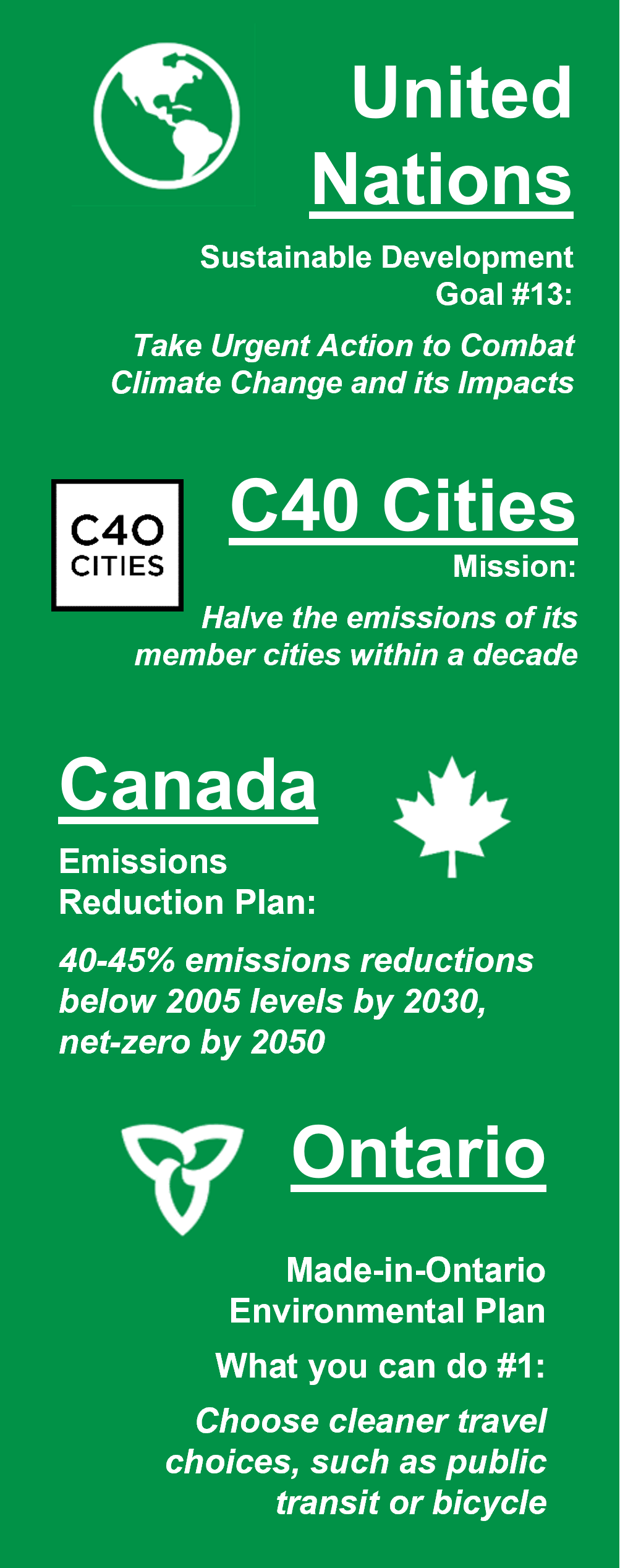Our commitment to environmental sustainability
The TTC is committed to doing its part to address the global climate emergency with a Global, Federal and Provincial Goals strategy and roadmap that prioritizes climate mitigation and adaptation efforts to achieve net zero greenhouse gas (GHG) emissions by 2040, while increasing our operational resilience to climate change.
Environmental sustainability work streams
Our commitment to environmental sustainability at the TTC is to do our part to address the global climate emergency, with a focus on eliminating TTC’s direct emissions, growing our ridership to avoid community emissions, and ensuring our operations are resilient to extreme weather events.
The Innovation and Sustainability Strategy is built on five workstreams. Each action encompasses an important part of the overall sustainability strategy for the TTC, ensuring the TTC employees, the community and the overall environment in which we operate are included in our purview.
| Work Streams | Goals | Benefits |
| Eliminate GHG Emissions | Support continued transit ridership growth to maximize city-wide avoided emissions and decarbonize TTC assets to minimize direct and indirect emissions. | Improve air and noise quality, reduce environmental impact and meet GHG emission reduction targets. |
| Reduce Consumption | Reduce water usage, minimize waste to landfill, increase recycled materials, and move towards a more circular economy to minimize indirect GHG emissions. | Protect the environment, maximize the value of our investments and resources, while providing new opportunities for employment in a circular economy. |
| Protect our Natural Ecosystem | Integrate natural ecosystems into the plans, designs and development of our assets. | Protect and restore local natural habitats, functions and biodiversity. |
| Build Climate Resilience | Identify assets vulnerable to extreme weather events, adopt mitigation measures to increase resilience against extreme weather events and increase energy resiliency. | Reduce frequency, duration and severity of service interruptions and associated economic impacts. |
| Climate and Fiscal Responsibility | Maximize net operating savings, cost avoidance, and the potential revenue from capital investments made to decarbonize our operations. | Apply savings and revenue to generate capital funding toward the TTC’s Innovation and Sustainability Program to 2040. Apply savings, cost avoidance and revenue to reduce fares post-2040. |
The 5Ws of environmental sustainability at the TTC
-
What is ‘sustainability’ at the TTC?
Sustainability at the TTC is the pursuit of impactful action to reduce GHG emissions, increase operational resiliency, responsibly consume limited resources improve community health and wellbeing, while maximizing service reliability for our customers.
-
Why practice sustainability at the TTC?
Over the next 20-30 years, Toronto is expected to see a tripling of high temperature days, from an average of 12 in the years 1976 1976-2005 to an annual average of 66 days per year above 30°C by 2050. These changes place a significant burden on local residents and critical infrastructure. Toronto has already experienced extreme weather events, such as major flooding, snow and ice storms, heatwaves, wildfire smoke and windstorms. Delaying action will only exacerbate the climate situation and increase the cost and difficulty of dealing with the consequences both locally and globally, while affecting our ability to deliver reliable and safe transit services. It is important for the TTC to reduce its environmental impact while increasing its resilience to the climate.
-
Where and When should ‘sustainability’ be a focus?
Taking public transit today is a sustainable option to travel. Furthering our sustainability in the future, our commitment will permeate every facet of the TTC. To achieve our net zero by 2040 target, we must act immediately. Achieving our targets cannot be simply solved with technological solutions alone. The TTC must work to adopt progressive designs and operational measures into all physical assets, while collaborating with local entities, such as the City of Toronto and Toronto Hydro, to increase the efficiencies of our interdependent public services. To start this process, the TTC will work to embed sustainability throughout its culture.
-
Who is responsible for sustainability at the TTC?
Environmental sustainability involves everyone. From frontline staff to leadership, customers to the general public, and industry peers to academia and vendors, everyone has the responsibility to engage and move us towards a sustainable future.
Global, Federal and Provincial Goals
